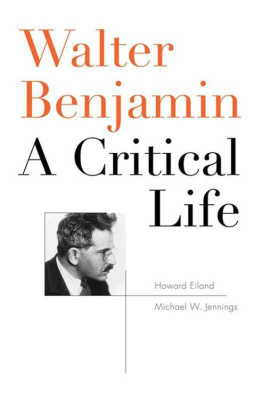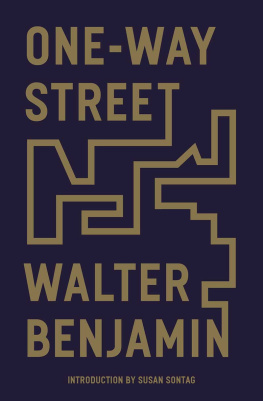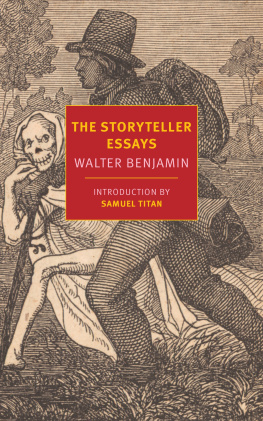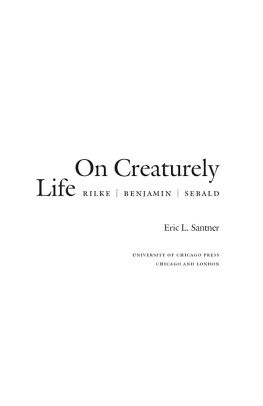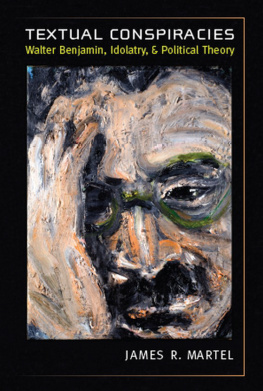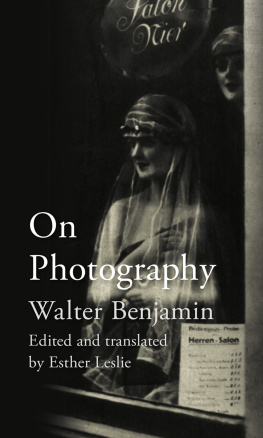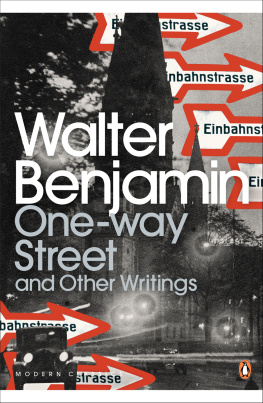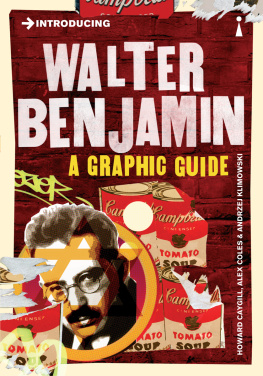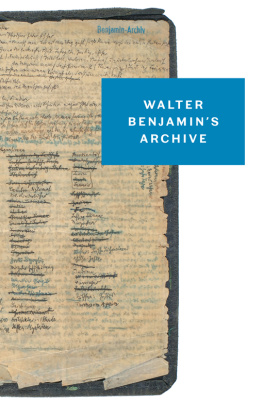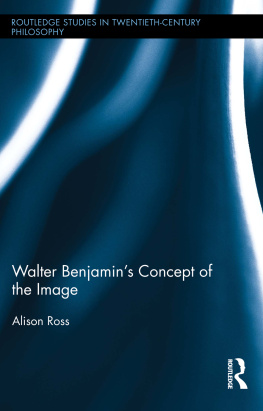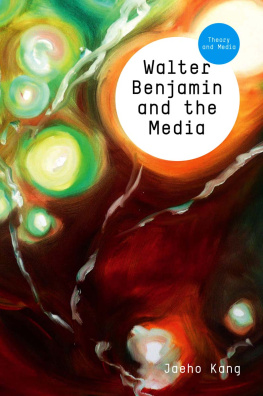Howard Eiland - Walter Benjamin: A Critical Life
Here you can read online Howard Eiland - Walter Benjamin: A Critical Life full text of the book (entire story) in english for free. Download pdf and epub, get meaning, cover and reviews about this ebook. year: 2014, publisher: Belknap Press, genre: Detective and thriller. Description of the work, (preface) as well as reviews are available. Best literature library LitArk.com created for fans of good reading and offers a wide selection of genres:
Romance novel
Science fiction
Adventure
Detective
Science
History
Home and family
Prose
Art
Politics
Computer
Non-fiction
Religion
Business
Children
Humor
Choose a favorite category and find really read worthwhile books. Enjoy immersion in the world of imagination, feel the emotions of the characters or learn something new for yourself, make an fascinating discovery.
- Book:Walter Benjamin: A Critical Life
- Author:
- Publisher:Belknap Press
- Genre:
- Year:2014
- Rating:5 / 5
- Favourites:Add to favourites
- Your mark:
- 100
- 1
- 2
- 3
- 4
- 5
Walter Benjamin: A Critical Life: summary, description and annotation
We offer to read an annotation, description, summary or preface (depends on what the author of the book "Walter Benjamin: A Critical Life" wrote himself). If you haven't found the necessary information about the book — write in the comments, we will try to find it.
Walter Benjamin: A Critical Life — read online for free the complete book (whole text) full work
Below is the text of the book, divided by pages. System saving the place of the last page read, allows you to conveniently read the book "Walter Benjamin: A Critical Life" online for free, without having to search again every time where you left off. Put a bookmark, and you can go to the page where you finished reading at any time.
Font size:
Interval:
Bookmark:
Walter Benjamin
Walter Benjamin

A Critical Life
Howard Eiland and Michael W. Jennings
The Belknap Press of Harvard University Press
CAMBRIDGE, MASSACHUSETTS LONDON, ENGLAND
2014
Copyright 2014 by the President and Fellows of Harvard College
All rights reserved
Jacket photo: Walter Benjamin, ca. 1929. Studio Jol-Heinzelmann, Akademie der Knste, Berlin, Walter Benjamin Archiv.
Jacket design: Jill Breitbarth.
The Library of Congress has cataloged the printed edition as follows:
Eiland, Howard.
Walter Benjamin : a critical life / Howard Eiland and Michael W. Jennings.
pages cm
Includes bibliographical references and index.
ISBN 978-0-674-05186-7 (alk. paper)
1. Benjamin, Walter, 18921940. 2. Authors, German20th centuryBiography. I. Jennings, Michael William. II. Title.
PT2603.E455Z6455 2013
838'.91209dc23
[B] 2013012858
Book design by Dean Bornstein
For Elizabeth, Dorothea, Matthew, and Rudolph
And for Sarah and Andrew
Contents
: 18921912
: Berlin and Freiburg, 19121914
: Berlin, Munich, and Bern, 19151919
: Berlin and Heidelberg, 19201922
: Frankfurt, Berlin, and Capri, 19231925
: Berlin and Moscow, 19251928
: Berlin, Paris, and Ibiza, 19291932
: Paris and Ibiza, 19331934
: Paris, San Remo, and Skovsbostrand, 19351937
: Paris, San Remo, and Skovsbostrand, 19381939
: Paris, Nevers, Marseilles, and Port Bou, 19391940
T HE German Jewish critic and philosopher Walter Benjamin (18921940) is now generally regarded as one of the most important witnesses to European modernity. Despite the relative brevity of his writing careerhis life was cut short on the Spanish border in flight before the Nazishe left behind a body of work astonishing in its depth and diversity. In the years following what he called his apprenticeship in German literature, during which he produced enduring studies of Romantic criticism, of Goethe, and of the Baroque Trauerspiel or play of mourning, Benjamin established himself in the 1920s as a discerning advocate of the radical culture emerging from the Soviet Union and of the high modernism that dominated the Parisian literary scene. In the second half of the 1920s, he was at the center of many of the developments now known as Weimar culture. Along with friends such as Bertolt Brecht and Lszl Moholy-Nagy, he helped shape a new way of seeingan avant-garde realismas it was breaking free of the mandarin modernism that had characterized German arts and letters under the Wilhelmine Empire. In this period, as Benjamin gained recognition for his writing, he harbored the not unreasonable hope of becoming the foremost critic of German literature. At the same time, he and his friend Siegfried Kracauer were virtually inventing popular culture as an object of serious study: Benjamin produced essays on childrens literature, toys, gambling, graphology, pornography, travel, folk art, the art of excluded groups such as the mentally ill, and food, and on a wide variety of media including film, radio, photography, and the illustrated press. In the last decade of his life, most of which was spent in exile, much of his writing originated as offshoots of The Arcades Project, his cultural history of the emergence of urban commodity capitalism in mid-nineteenth-century France. Although The Arcades Project remained a massive unfinished torso, the research and reflection that informed it generated a series of groundbreaking studies, such as the celebrated 1936 polemic The Work of Art in the Age of Its Technological Reproducibility and the essays on Charles Baudelaire that established the poet as the representative writer of modernity. But Benjamin was not only a surpassing critic and revolutionary theorist: he also left a substantial body of writing on the border between fiction, reportage, cultural analysis, and memoir. His 1928 montage book One-Way Street , and especially Berlin Childhood around 1900, which remained unpublished in his lifetime, are modern masterpieces. In the end, many of Benjamins works defy simple generic classification. Among the prose works long and short are monographs, essays, reviews, collections of philosophical, historiographical, and autobiographical vignettes, radio scripts, editions of letters and of other literary-historical documents, short stories, dialogues, and diaries. There are also poems, translations of French prose and poetry, and myriad fragmentary reflections of differing length and import.
The concentrated image worlds evoked on the pages of these works bring into view some of the most turbulent decades of the twentieth century. Growing up in an assimilated, well-to-do Jewish family in Berlin in the years around 1900, Benjamin was a child of the German Empire: his memoirs are filled with recollections of the monumental architecture beloved of the kaiser. But he was also the child of an explosive urban capitalist modernity; by 1900 Berlin was Europes most modern city, with new technologies burgeoning everywhere. As a young adult he opposed Germanys involvement in the First World War and in consequence spent most of the war years in Switzerlandyet visions of the wars nights of annihilation pervade his work. In the course of the Weimar Republics fourteen-year existence, Benjamin experienced first the bloody conflict between radical left and radical right that followed the end of the war, then the devastating hyperinflation of the early years of the young democracy, and finally the debilitating political fragmentation of the late 1920s that led to the seizure of power by Hitler and the National Socialists in 1933. Like almost every important German intellectual of the day, Benjamin fled the country in the spring of 1933, never to return. He spent the final seven years of his life in a Parisian exile characterized by isolation, poverty, and relative lack of publishing venues. He was never able to forget that there are places where I can earn a minimal amount, and places where I can subsist on a minimal amount, but nowhere in the world where these two conditions coincide. The final period of his career saw the shadow of coming war extend across Europe.
Why do Benjamins works continue to speak so compellingly to the general reader and the scholar alike, more than seventy years after his death? There is the power of his ideas, first of all: his work has reshaped our understanding of many important writers, of the possibilities of writing itself, of the potentials and hazards of technological media, and of the situation of European modernity as a historical phenomenon. Yet one fails to appreciate his full impact if one ignores its distinctively etched verbal mediumthe uncanny Benjaminian style. Purely as a crafter of sentences, Benjamin bears comparison to the most supple and penetrating writers of his day. And he was a pioneering formal innovator: his most characteristic works are based on what he came to call, after the poet Stefan George, the Denkbild or figure of thought, an aphoristic prose form combining philosophical analysis with concrete imagery to yield a signature critical mimesis. Even his ostensibly discursive essays are often secretly composed of sequences of these trenchant thought images, arranged according to the principles of avant-garde montage. It was Benjamins genius to find the forms within which a profundity and complexity fully comparable to that of contemporaries such as Heidegger and Wittgenstein could resonate through an immediately engaging and memorable prose. Reading him is therefore a sensory, no less than intellectual, experience. It is like the first taste of a tea-soaked madeleine: dimly remembered worlds blossom in the imagination. And as the phrases linger, constellate, and begin permutation, they subtly attune themselves to an emerging recombinatory logic, slowly releasing their destabilizing potential.
Next pageFont size:
Interval:
Bookmark:
Similar books «Walter Benjamin: A Critical Life»
Look at similar books to Walter Benjamin: A Critical Life. We have selected literature similar in name and meaning in the hope of providing readers with more options to find new, interesting, not yet read works.
Discussion, reviews of the book Walter Benjamin: A Critical Life and just readers' own opinions. Leave your comments, write what you think about the work, its meaning or the main characters. Specify what exactly you liked and what you didn't like, and why you think so.

